Estuarine morphological modelling
Contents
Introduction
Estuaries are the areas where terrestrial and marine waters meet. This means that they are influenced by fresh water flow and sediment transport from rivers, as well as by saline marine water and sediment via tides, storm surges, waves and wind. There is a strong mutual interaction with the complex ecosystem. Moreover, due to their position between land and sea, they are often areas of intense human activity.
From a morphological point of view, there is a complex dynamic interaction between four groups of elements: channels, sandy shoals, mudflats and marshlands. They are influenced by the motion of fresh and saline waters. The transport of sediment, often a mix of sand and fines, involves a variety of mechanisms.
Describing this in all its complexity requires highly sophisticated high-resolution simulation models. Yet, it is sometimes possible to derive useful information on certain aspects of estuarine morphology with simpler models. In this chapter we will describe some of these simpler model concepts, as well as how and when they can be applied. Examples refer to Dutch estuaries, where much groundbreaking work was done.
Model typology
Before going into the specific aspects of estuarine morphological modelling, we will set up a typology of the models to be considered (also see De Vriend[1]). In broad outline, they can be classified as in the scheme at the right. Other model types can probably be added, but these are the most commonly used ones.
A conceptual model basically consists of one or more notions of how the system responds to external factors. For instance: the shoal level will tend to follow a rise in high water level. The essence of empirical models is that they are based on observations / data. They can range from a simple line fitted through data in a scatter diagram to relationships based on artificial intelligence, such as neural networks. A simple example is the empirically established relationship between the cross-sectional area below mean sea level of a tidal channel and the tidal discharge that moves through it.
Semi-empirical are based on a combination of data or observed behaviour and basic conservation laws, such as a sediment mass balance. An example from coastal morphology is a diffusion-type profile model, which is based on observed behaviour and satisfies the sediment balance equation, while the diffusion coefficient is derived from observations or more sophisticated model results. Genetic algorithms partly based on physical knowledge, such as a known property of a sediment transport relationship, also come under this category.
Physical models can be physical scale models or analogs. An example of the latter is the Deltar, an electrical analog formerly used by Rijkswaterstaat to produce forecasts of tides and surges (see https://en.wikipedia.org/wiki/Deltar).
There is multitude of mathematical models, in one, two or three spatial dimensions. Most of the hydrodynamic models in this category are process-based, i.e. based on the conservation laws of mass and momentum from classical physics. The constituting equations, such as the Navier-Stokes equations for turbulent flow, are solved in various degrees of simplification.
Analytical models seem to be regaining ground now that techniques become available to tackle systems of nonlinear equations (e.g. Schuttelaars and de Swart[2]).
Lumped or aggregated models basically involve a reduction of the number of spatial dimensions. Box models have no spatial dimension at all, i.e. they consider processes within a bounded volume or at a arbitrary point in space. They are often used in ecology (e.g. food chain models). Pots&pipes models lump processes into a number of interconnected containers or spatial boxes, and describe how the fluxes between those boxes influence the state of the dependent variables within them, and how the state of the dependent variables influences the fluxes. An example of such a model is ASMITA, which has been used extensively to describe the morphological behaviour of short tidal embayments such as those in the Wadden Sea (Stive and Wang[3] ).
Spatially integrated models reduce the number of dimensions by formally integrating the constituting equations over one or more spatial dimension. An example is ESTMORF, which describes the morphological evolution of a tidal channel and shoal system as a 1-D network with the shoals as storage areas for water and sediment (Wang et al.[4]).
Grid-based models form a very large category of mathematical models. They exist in a variety of forms, to be distinguished by the type of grid and by the way the constituting equations are discretized and solved. In the case of morphological models, an important aspect is how the hydrodynamic, sediment transport and sediment balance components of the model are coupled, at time-step level (like Delft3D; see Lesser et al. [5]) or at intertidal level. A special category of grid models are cellular automata (e.g. Dearing et al.[6]), in which objects can move from one box to another according to prescribed rules of behaviour and driven by the conditions in the box where they are and its neighbours. Thus it is a mixed form of grid-based and particle-based models.
Particle-based models are increasingly used now that computer power has sufficiently increased. Spectacular results have been obtained with Smooth Particle Hydrodynamics (SPH), especially with highly non-linear water motion at small scales (e.g. breaking waves). Random walk models were formerly used only at the analytical level, in order to come up with parameterisations of e.g. turbulence or turbulent sediment transport in turbulent flow. Random-walk numerical simulation models seem to be coming within sight now. In sediment transport, grain-by-grain transport models are gaining ground, as they circumvent part of the empiricism of traditional sediment transport models. Especially in complex areas such as estuaries, this may become an important asset. Swarm models describe the behaviour of large numbers of mutually interacting particles, such as emergent pattern formation. They may become of interest for cohesive sediment (e.g. flocculation), but this kind of application still seems to be beyond the horizon.
Short tidal basins
Tidal basins which are small as compared with the tidal wavelength allow for a special kind of modelling, based on the approximation that at every point in time the water surface elevation is in phase throughout the basin. This simplifies the hydrodynamic computation significantly. Many tidal basins on barrier island coasts are of this type. One example is the Northwest European Wadden Sea, which extends from the Netherlands through the German Bight through to Denmark (Fig. 1). It consists of a range of tidal basins, separated by more or less pronounced drainage divides. Wherever expedient in the model descriptions below, example applications from this system are shown, even though most models have been used for a variety of other systems, as well.
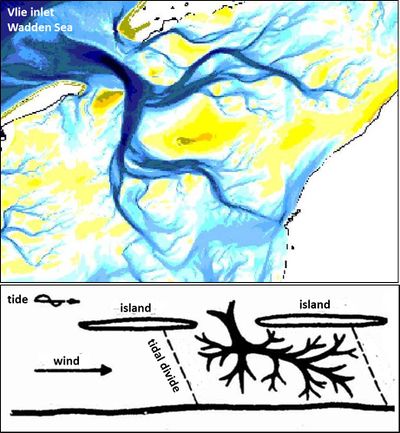
Important morphological elements within each basin are channels, shoals and mudflats and marshlands in the back. Typical channel networks in such basins are like the branches of an apple tree (Van Veen[7]), i.e. with higher-order bifurcations (Fig. 2). There is a significant long-term interaction between the morphology of the basin, the ebb-tidal delta and the adjacent coastlines: they form a sediment-sharing system (also see Cowell et al. [8]).
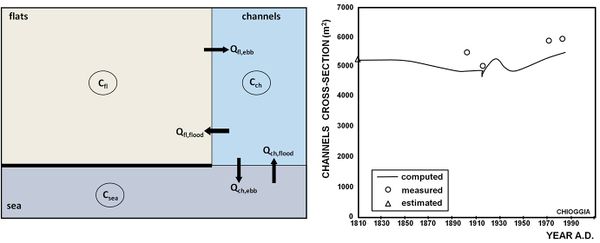
A large amount of empirical evidence is available on certain aspects of the morphological equilibrium state of such systems. The cross-sectional area of the inlet and the channels, for instance, is approximately proportional to the tidal prism, i.e. the volume of water which moves up and down the channel during a tidal cycle (O’Brien[10]). Also, the volume of the basin below mean sea level is approximately proportional to the tidal prism to a power between 1 and 1.5 (Eysink[11]). Such empirical relationships are the basis of a number of conceptual models of the large-scale behaviour of this type of short tidal basins (e.g. de Vriend [1]). They also allow for a special kind of morphological models: closed-loop models which basically describe the deviation from the (empirical) equilibrium state. These models are complementary to open-loop ones, which start from a given state and integrate the constituting equations through time without prescribing the equilibrium state.
There is a whole family of aggregated models for this type of systems. Di Silvio[9] proposed a simple two-box model in which all channels and all shoals are lumped, respectively. The basic equations are the integrated water and sediment balances, combined with relationships between the sediment concentration and the state of the shoals and the channels, respectively. They can be elaborated to a set of two coupled relaxation equations describing the long-term morphological evolution of the basin. This type of model is only suitable to describe very long-term morphological changes, say at the scale of centuries, and only for systems with no strong interaction with the ebb-tidal delta. The model was applied successfully to the past evolution of Venice Lagoon (Fig. 3).
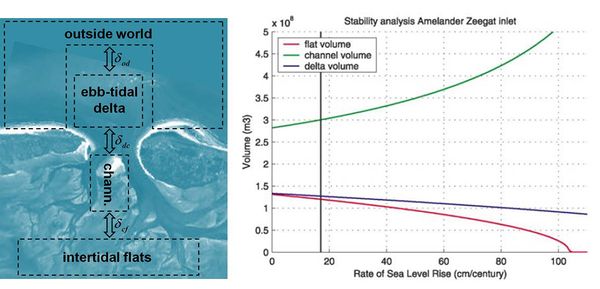
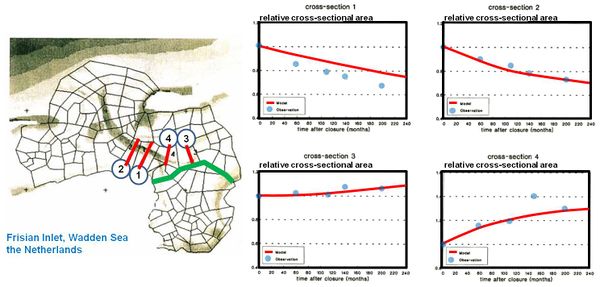

A lumped model including the interaction with the outer delta and the adjacent coastlines is ASMITA (Stive and Wang[3]; also see Townend et al.[14][15]). It is basically a semi-empirical closed-loop pots&pipes model, with sediment-containing boxes for the basin, the ebb-tidal delta, and the coastlines and transport relationships depending on the state of these boxes to describe the fluxes between them. As this model includes more of the dynamic interactions, it can be applied at somewhat shorter timescales, say decades to centuries. The model has been used in many applications, among which the long-term response of the Wadden Sea to accelerated sea level rise (Van Goor et al.[12] ). It showed that at a certain rate of sea level rise the system is no longer able to keep pace with the rising sea level (Fig 4).
Later on, ASMITA was integrated with the multi-coastline model PONTOS, as a tool to model the overall sediment balance of the Dutch coast, including the Wadden Sea barrier-island coast [16]. A more detailed model of the interaction between basin, ebb-tidal delta and adjacent coast is given by de Vriend et al. [17], showing that the outer delta act as a buffer between the other two elements.
Going one step further in the description of the internal hydrodynamics in the basin, one may use a 1-D network model to describe flow and sediment transport in the channel network and combine that with a semi-empirical description of the water and sediment exchange with the shoals. Di Silvio[9] proposed a model of that type and ESTMORF (Wang et al.[4]) is another example. This type of closed-loop model is primarily meant to be applied inside the basin, as it is difficult to include the interaction with the ebb-tidal delta. Such a model has been used, for instance, to analyse the response of the Frisian Inlet to the closure of one third of the basin area (Fig. 5).
Open-loop process-based grid models, such as 2-D depth-averaged morphological simulation models, have also been applied to these short basins (e.g. De Vriend and Ribberink[18]). Some of these applications focus on the morphological evolution of the channel pattern, others on larger-scale aspects like the response to sea level rise. Delft3D, for instance, has been used for various short-basin applications. Marciano et al. [13]) and Dissanayake et al. [19] ) used it to simulate the channel pattern evolution in a hypothetical basin, starting from a smooth topography (Fig. 6). This type of results raises the question how to compare morphological model results with observations, so how to derive essential properties of the channel pattern from them. A local statistical comparison like the Brier Skill Score [20] (also see the section below) is probably not good enough here.
Dastgheib et al. [21] used the same software package to model the response of the Marsdiep basin to sea level rise. He concludes that this type of process-based model system is suitable for long-term applications, and that the results seem to indicate a dependence of the large-scale equilibrium state on the initial conditions.
Most of these models assume a sandy bed, often with uniform sediment. Usually, tidal basins contain a significant amount of mud, so modelling a combination of sand and fines may be useful. An important aspect to be properly modelled is the behaviour of fines in the water column (flocculation, hindered settling, turbulence damping) and their buffering in and pick-up from the top layer of the bottom. Van Prooijen and Wang[22] present a spatially lumped model for fines under the influence of tides and waves. Van Ledden et al. [23] used a process-based model for the deposition of fines in the Wadden Sea. New insights into mud erosion (Winterwerp et al.[24]) have led to more models that are suitable to address issues in which mud erosion also plays a role (also see Section 4).
Longer tidal estuaries

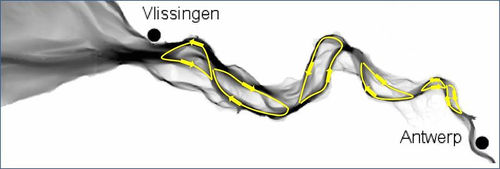
Many estuaries do not allow for the assumption that the tidal wave is in phase throughout the system. In these longer estuaries other phenomena play a role, such as tidal propagation and deformation, residual currents and sediment transport, and estuarine circulation. Also, the pattern of channels and shoals tends to be different. Van Veen[7] calls this a ‘poplar tree’ structure, with continuing ebb-dominated channels and interrupted flood-dominated channels (Fig. 7).
The Western Scheldt (Westerschelde) is an example of such an estuary (Figs. 7, 8). It connects the river Scheldt with the North Sea, but the river discharge is small compared with the ebb and flood discharges. The estuarine ‘quadruplet’ (channels, shoals, mudflat, marshlands) is clearly present in its full dynamic interaction. There is a large submerged outer delta, called ‘Vlakte van de Raan’. The estuary gives access to the harbour of Antwerp and is therefore an important fairway for commercial navigation. The estuary’s planform has been heavily influenced by many centuries of consecutive embankments. The functioning of the models described below are illustrated by applications to this estuary, even though most of them have also been applied to a range of other systems.
Management objectives for this estuary aim to reconcile safety, accessibility and naturalness. Given the frequent human interventions, this explains why this system has been studied extensively, via field work as well as a wide range of models. It is therefore a rich source of examples of estuarine morphological modelling.
Commercial interests constitute a drive to deepen the fairway, such that it requires more or less continuous maintenance. Maintenance dredging in the Western Scheldt tends to focus on a number of thresholds in the ebb-dominated main channel. Because these are rather local phenomena, it may be tempting to use a point model relating the rate of accretion to the local over-depth. Such an approach, however, would ignore any limited availability of sediment from the surroundings. Wang et al. [26] go one step further by relating the sediment supply towards such a point to the sediment availability in neighbouring areas and embedding this relationship in an ESTMORF network model. This model was used, for instance, to study the effects of dredging and dumping strategies in the Western Scheldt. An adapted version of ASMITA was used to model the interaction with the outer delta, and further extensions of this concept were applied to other estuaries, such as the Humber (Townend et al. [14]).
Residual currents and residual sediment transport play a key role in the morphology of estuaries such as the Western Scheldt. Without considering the residual transport field, it is impossible to explain the formation of the channel-shoal system. Note, however, that residual current patterns can be quite different from residual transport patterns, sometimes even with opposite directions. It is fair to state that in an estuary like this the residual transport pattern cannot be estimated from the residual current pattern. The residual transport pattern in the Western Scheldt exhibits a remarkable pattern: a number of consecutive circulation cells around the major shoal complexes (Fig. 9; also see Van Veen[7] and Winterwerp et al. [25] ).
The question where to dump the dredged material has been subject of many discussions, among others about the stability of the multiple channel system (Fig. 9), which is considered ecologically important. Jeuken and Wang[27] studied this for individual cells using an analytical method and concluded that there is a limit to the amount of material that can be dumped per unit time in one of the channels forming a cell. If this limit is exceeded, the cell will degenerate to a single channel. Note that this type of analysis is relevant in its own right, but also provides information that can be compared with results of more complex simulation models. The same goes for so-called idealized analytical models (e.g. Schuttelaars and de Swart[2]), i.e. models reduced to the essential physics and simplified far enough to allow for an analytical approach. They give insight into basic processes and phenomena that may not be directly visible from the results of detailed numerical models, such as the possible existence of multiple equilibria (Schramkowski et al. [28]).
One of the first applications of an open-loop grid model to long-term estuarine morphology is described by Hibma[29]. She simulated the morphological evolution in a hypothetical estuary of constant width with a 2-D depth-integrated Delft3D-model, starting from a seaward sloping flat bed with a small random perturbation. The results (see the movie below) show that the initial bedforms, diagonally crossing regular waves corresponding with the linearly most unstable mode, soon evolve into a much more complex and larger-scale pattern similar to Van Veen’s[7] ‘poplar tree’.
As this model did not include any complexities, such as 3D secondary flows or relaxation of suspended sediment concentrations, these results show that much of the larger-scale behaviour of this type of systems is governed by rather basic flow and sediment transport processes.
Van der Wegen and Roelvink[30] applied a Delft3D-model to the actual planform of the Western Scheldt, starting from a plane bed. This evolved into a channel-shoal geometry showing a striking resemblance to the actual one in the estuary (see the movie below). Results turned out to be hardly sensitve to estuarine circulation, grainsize variations or bank erodibility. There was a significant sensitivity, however, to the seaward boundary conditions (overtides), the bedslope effect on the sediment transport and three-dimensionality of the flow. Also, significant effects were found of erodibility restrictions, e.g. due to hard layers in the bottom, and of human activities such as dredging and dumping.
In order to assess the model results, one may use the Brier Skill Score (e.g. Sutherland et al. [20]). It is based on an rms-type evaluation of the local differences between the model results and a given reference. It can be split into sub-scores for the large-scale trend and for amplitude and phase errors in the deviations from that trend. In the case of the above model, it reveals a difference in evolution timescale of the channel-shoal system and the large-scale slope of the estuary.
Dam et al. [31] use a different model system (FINEL; see Dam and Bliek[32]), based on finite elements, to model the long-term morphological evolution of the Western Scheldt. They evaluate the Brier Skill Score by comparing the model results with measured data (Fig. 10, also note Bosboom et al.[33]).
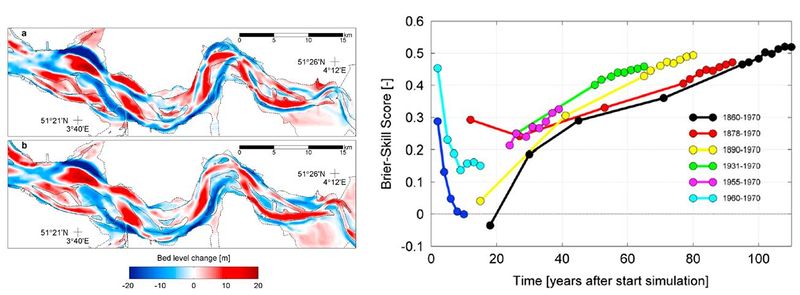
In the early stages of the simulation, the score rapidly decreases, down to negative values. This is attributed to spin-up effects of the model and the absence of relevant scales in the initial conditions. After some time, however, the score increases, up to values that are considered excellent. Moreover, the results indicate that the system tends towards an equilibrium state corresponding with minimum dissipation of hydrodynamic energy. This leads to the conclusion that, in the Western Scheldt situation with all its constraints, open- loop process-based morphodynamic models may be better suited for long-term applications than for shorter-term ones.
Morphological changes, man-made or natural, in this type of estuaries may have important environmental effects. This concerns not only the direct effects of channel and shoal formation, but also indirect effects on the estuary and its surroundings. One example is channel deepening, which may lead to an enhanced net import of fine sediment. As a consequence, a regime shift may occur from a low-concentration and ecologically rich system to a high-concentration and ecologically impoverished system, like in the Ems and the Loire (Winterwerp and Wang[34]). Now that the Western Scheldt in exporting sediment (Fig. 11 top; see VNSC[35]), the main channel is likely to deepen, fines are being imported (Fig 11 bottom) and this regime shift may well be imminent (Winterwerp et al. [36]).
Lessons learned
- Multiple equilibria and tipping points are possible in the kind of systems considered herein; these phenomena cannot be found from a single run with a numerical model.
- Good morphological modelling involves not only inclusion of the relevant physical mechanisms (as little as possible, as much as needed) in the constituting model equations, but also:
- a proper choice of the aggregation level, given the information one expects from the model;
- adequate parameter setting, depending on the type of model. - In the case of closed-loop models:
- well-considered lumping of elements, in line with the model concept;
- careful interpretation of measured data in terms of the assumed equilibrium state (example: Wadden Sea basins in equilibrium during ongoing holocene sea level rise?). - In the case of open-loop models:
- adequate parameter setting (e.g. bed roughness, exchange coefficients, sediment grain size or granulometry, sediment transport parameters, timescale factor);
- proper location of the boundaries, given the information available for the boundary conditions (from measurements or from ambient models); in the case of a strong interaction with the ebb-tidal delta, for instance, it makes little sense to place a model boundary in the gorge of the tidal inlet or the estuary mouth;
- well-chosen hydrodynamic boundary conditions; as the drivers of estuarine processes are variable, some randomly (e.g. storm surges and wave events) and some at a wide range of timescales (tides), it is hardly feasible to drive models for hundreds of years with a realistic time signal; hence the boundary conditions need to be schematized carefully in order to represent the net effect of these variable conditions; special attention needs to be paid to overtides, because they correspond with tidal asymmetry, hence a residual transport capacity;
- well-considered boundary conditions for the sediment transport; if there is a net river inflow, this will bring sediment into the system and a net sediment flux needs to be imposed at the upstream boundary; in the case of suspended load transport, a transport boundary conditions is also needed at the seaward boundary; this condition has to take into account that sediment exported during ebb does not simply vanish to open sea, but lingers on the ebb-tidal delta and may be transported back by the next flood;
- well-chosen erodibility conditions, at the bottom (hard layers) as well as at erodible lateral boundaries (displacement rate, sediment production);
- initial conditions preferably resolving the relevant spatial scales;
- don’t forget wind forcing within the model area, especially when taking extreme events into account; given the pronounced topography in an estuary or tidal basin, wind forcing will give rise to horizontal circulations, grossly along with the wind direction in shallow areas and against the wind direction in the deeper channels between them; note that wind forcing also puts demands on the nature of the boundary conditions. - Simplified analytical models and numerical models for idealized situations (e.g. a straight or funnel-shaped estuary) may give useful additional insight into the morphological behaviour and help validating more complex and refined models.
- In the case of complex systems like estuaries and tidal basins, model results are usually not reliable in every detail; rather should one focus on overall patterns, such as channel-shoal patterns, and trends; given the random forcing, it might even be recommendable - computer power permitting - to run models in ensemble-mode, in order to have an impression of the range of possible outcomes.
- In view of the previous point, assessing model results by point-to-point comparison with measured data is difficult; statistical approaches, such as the Brier Skill Score and its sub-scores, may provide more useful information.
- Even if model results tend to deviate more from measured data as time proceeds, this does not mean that the model performance in terms of the Brier Skill Score gets worse; in a system like the Western Scheldt, the score may even increase to excellent in the long run;
- Movies of model results and consecutive topographic surveys reveal a lot more information than a series of static plots.
Related articles
Definitions, processes and models in morphology
Physical processes and morphology of synchronous estuaries
References
- ↑ 1.0 1.1 De Vriend HJ (1995). Mathematical modelling of meso-tidal barrier island coasts, Part I: Empirical and semi-empirical models. In: Liu PL (ed.), Advances in Coastal and Ocean Engineering, Vol. 2, World Scientific Publication Company, Singapore, pp 115-149.
- ↑ 2.0 2.1 Schuttelaars HM & de Swart HE (2000). Multiple morphodynamic equilibria in tidal embayments. JGR-Oceans 105(C10): 24105-24118.
- ↑ 3.0 3.1 Stive MJF & Wang ZB (2003). Morphodynamic modeling of tidal basins and coastal inlets. In: Lakhan V.C. (ed.), Advances in Coastal Modeling, Elsevier Oceanography Series 67: 367-392. doi: 10.1016/s0422-9894(03)80130-7
- ↑ 4.0 4.1 4.2 Wang ZB, Karssen B, Fokkink RJ & Langerak A (1998). A dynamic-empirical model for estuarine morphology. In: Dronkers J & Scheffers MBAM. (Eds.), Physics of Estuaries and Coastal Seas, Balkema, Rotterdam, pp. 279-286.
- ↑ Lesser GR, Roelvink JA, van Kester JATM & Stelling GS (2004). Development and validation of a three-dimensional morphological model. Coastal Engineering 51: 883-915. doi: 10.106/jcoastaleng.2004.07.014
- ↑ Dearing JA, Richmond N, Plater AJ, Wolf J, Prandle D & Coulthard TJ (2006). Modelling approaches for coastal simulation based on cellular automata: the need and potential. Phil. Trans. R. Soc. A 364: 1051–1071. doi: 10.1098/rsta.2006.1753
- ↑ 7.0 7.1 7.2 7.3 7.4 7.5 Van Veen J (1950). Ebb and flood channel system in the Netherlands tidal waters. Tijdschrift Koninklijk Nederlands Aardrijkskundig Genootschap, 2nd series, Vol. 67, pp. 303-325 (in Dutch). Also see: Van Veen J, van der Spek A, Stive MJF & Zitman TJ (2005). Ebb and flood channel systems in the Netherlands tidal waters. J. Coastal Res. 21(6): 1107-1120. doi:10.2112/04-0394.1
- ↑ Cowell PJ, Stive MJF, Niedoroda AW, de Vriend HJ, Swift DJP, Kaminsky GM. & Capobianco M (2003). The coastal-tract (Part 1): a conceptual approach to aggregated modeling of low-order coastal change. J. Coastal Res. 19(4): 812-827
- ↑ 9.0 9.1 9.2 Di Silvio G (1989). Modelling the morphological evolution of tidal lagoons and their equilibrium configuration. In: Proc. XXIIIrd IAHR Congress, Ottawa, Canada, p. C.169 175.
- ↑ O’Brien MP (1931). Estuary tidal prism related to entrance areas. Civ. Eng. 1(8): 738-739. Also see: O'Brien MP (1969). Equilibrium flow areas of inlets on sandy coasts. Proc. ASCE, Jnl. Waterways, Harbours and Coastal Engrg., 15(WW1): 43 52.
- ↑ Eysink WD (1990). Morphologic response of tidal basins to changes. In: B.L. Edge (ed.), Coastal Engineering 1990 Proc., ASCE, New York, p. 1948 1961.
- ↑ 12.0 12.1 Van Goor M, Zitman TJ, Wang ZB & Stive MJF (2003). Impact of sea level rise on the morphological equilibrium state of tidal inlets. Marine Geology 202: 211-227. doi: 10.1016/s0025-3227(03)00262-7 Cite error: Invalid
<ref>tag; name "G" defined multiple times with different content - ↑ 13.0 13.1 Marciano R, Wang ZB, Hibma A, de Vriend HJ & Defina A (2005). Modeling of channel patterns in short tidal basins. JGR - Earth Surface 110, paper F01001, 13 pp. doi: 10.1029/2003JF000092 Cite error: Invalid
<ref>tag; name "M" defined multiple times with different content - ↑ 14.0 14.1 Townend I, Wang ZB, Stive MJF & Zhou Z (2016a). Development and extension of an aggregated-scale model: Part 1 - Background to ASMITA. China Ocean Engineering 30(4): 483-504. doi: 10.1007/s13344-016-0030-x
- ↑ Townend I, Wang ZB, Stive MJF & Zhou Z (2016b). Development and extension of an aggregated-scale model: Part 2 - Extensions to ASMITA. China Ocean Engineering 30(5): 651-670. doi: 10.1007/s13344-016-0042-6
- ↑ Steezel HJ, Wang ZB & Mulder JPM (2004). Large-scale sand balance of the Netherlands coastal system; modelling of a policy indicator. In: McKee Smit J (ed.): Coastal Engineering 2004, World Scientific 2005, Vol I: 2973-2984. ISBN 981-256-997-9
- ↑ de Vriend HJ, Bakker WT & Bilse DP (1994). A morphological behaviour model for the outer delta of mixed-energy tidal inlets, Coastal Engineering 23(3-4): 305-327
- ↑ de Vriend HJ & Ribberink JS (1995). Mathematical modelling of meso-tidal barrier island coasts, Part II: Process-based simulation models. In Liu PL (ed.), Advances in Coastal and Ocean Engineering, Vol. 2, World Scientific Publication Company, Singapore, pp 151-197
- ↑ Dissanayake DMPK, Roelvink JA & van der Wegen M (2009). Modelled channel patterns in a schematized tidal inlet. Coastal Engineering 56 (2009): 1069–1083. doi:10.1016/j.coastaleng.2009.08.008/
- ↑ 20.0 20.1 Sutherland, J, Peet, AH, Soulsby, RL (2004). Evaluating the performance of morphological models. Coastal Engineering 51(8-9): 917-939; doi: 10.1016/j.coastaleng.2004.07.015
- ↑ Dastgheib A., Roelvink JA. & Wang, ZB. (2008). Long-term process-based morphological modeling of the Marsdiep tidal basin. Marine Geology 256(1-4): 90-100. doi: 10.1016/j.margo.2008.10.003
- ↑ Van Prooijen BC & Wang ZB (2013). A 1-D model for tides, waves and fine sediments in short tidal basins: application to the Wadden Sea. Ocean Dynamics 63(11): 1233-1248. doi:10.1007/s10236-013-0648-7
- ↑ Van Ledden M, Wang Z & Winterwerp H (2006). Modeling sand-mud morphodynamics in the Friesche Zeegat. Ocean Dynamics 56(3): 248-265. doi: 10.1007/s10236-005-0055-9
- ↑ Winterwerp JC, van Kesteren WGM, van Prooijen BC & Jacobs W (2012). A conceptual framework for shear shear flow–induced erosion of soft cohesive sediment beds. JGR - Oceans 117(C10), 17 pp. doi: 10.1029/2012JC008072
- ↑ 25.0 25.1 Winterwerp JC, Wang ZB, Stive MJF, Arends A, Jeuken C, Kuijper C & Thoolen PMC (2001). A new morphological schematization of the Western Scheldt estuary. In: Proc. 2nd RCEM Symposium, Obihiro, Japan, p. 525-533.
- ↑ Wang ZB, Jeuken MCJL & Kornman BA (2003). A model for predicting dredging requirement in the Westerschelde. In: Proceedings International Conference on Estuaries and Coasts 2003, IRTCES, Zhejiang Institute of Hydraulics and Estuary, ISBN 7-900662-67-7/G.79, pp 429-435.
- ↑ Jeuken MCJL & Wang ZB (2010). Impact of dredging and dumping on the stability of ebb–flood channel systems. Coastal Engineering 57: 553-566. doi: 10.1016/j.coastaleng.2009.12.004
- ↑ Schramkowski G, Schuttelaars HM & de Swart HE (2004). Non-linear channel-shoal dynamics in long tidal embayments. Ocean Dynamics 54: 399-407. doi: 10.1007/s10236-003-0063-6
- ↑ Hibma A (2004). Morphodynamic modelling of estuarine channel-shoal systems. PhD thesis, Delft University of Technology. See: http://repository.tudelft.nl/islandora/object/uuid%3Af99c575b-b76b-4aa7-851d-0dca3d380759?collection=research
- ↑ Van der Wegen M & Roelvink JA (2012). Reproduction of estuarine bathymetry by means of a process-based model: Western Scheldt case study, the Netherlands Geomorphology 179: 152-167. doi: 10.1016/j.geomorph.2012.08.007
- ↑ 31.0 31.1 Dam G, van der Wegen M, Labeur RJ & Roelvink D. (2016). Modeling centuries of estuarine morphodynamics in the Western Scheldt estuary, Geophys. Res. Lett. 43. doi:10.1002/2015GL066725
- ↑ Dam G, Bliek AJ, Labeur RJ, Ides SJ & Plancke YMG (2007) Long-term process-based model of the Western Scheldt estuary. In: Dohmen-Janssen C.M & Hulscher SJMH (eds.), Proc. RECEM 2007, Taylor & Francis, London, p. 1077-1084.
- ↑ Bosboom J, Reniers AJHM & Luijendijk AP (2014). On the perception of morphodynamic model skill. Coastal Engineering 94: 112-125. doi: 10.1016/j.coastaleng.2014.08.008
- ↑ Winterwerp JC & Wang ZB, 2013. Man-induced regime shifts in small estuaries - I: theory. Ocean Dynamics 63(11): 1279-1292. doi: 10.1007/s10236-013-0662-9
- ↑ VNSC (2013). Large-scale sediment balance of the Western Scheldt. Vlaams Nederlandse Scheldecommissie, LTV Veiligheid en Toegankelijkheid, Basic report G-2, October 2013, 81 pp. See: http://www.vnsc.eu/uploads/2014/02/g-2-grootschalige-sedimentbalans-van-de-westerschelde-v2-0.pdf
- ↑ Winterwerp JC, Wang ZB, van Braeckel A, van Holland G.& Kösters F (2013). Man-induced regime shifts in small estuaries - II: a comparison of rivers. Ocean Dynamics 63(11): 1293-1306. doi: 10.1007/s10236-013-0662-8
Please note that others may also have edited the contents of this article.
|



